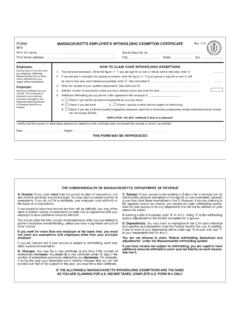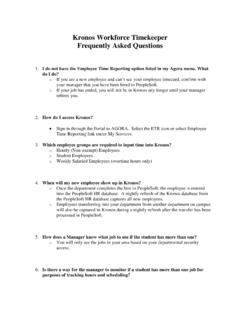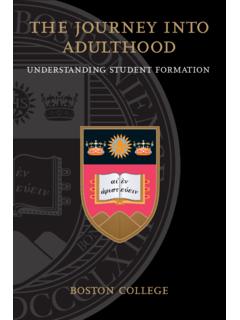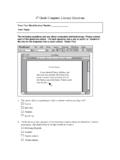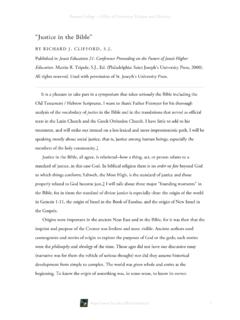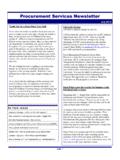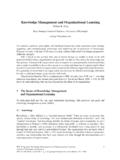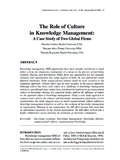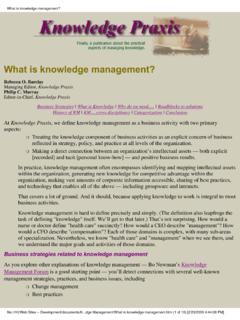Transcription of reverse mentoring at the hartford - Boston College …
1 Innovative practice brief may 2013. reverse mentoring at the hartford : Cross-Generational transfer of knowledge About Social Media Kim Lee DeAngelis, 1. table of contents Acknowledgements 3. About This Innovative Practice Brief 4. Why The hartford Embarked on reverse mentoring 5. Impetus from The hartford 's management 5. Impetus from The hartford 's junior employees 6. Convergence of interests 6. How The Company Implemented The Innovation 7. Tools for the company's reverse mentoring project 10. How reverse mentoring Changed The Company 13. Reasons For reverse mentoring 's Success at The hartford 14. What The hartford Learned About reverse mentoring That Can Benefit Other Companies 15. About the Sloan Center on Aging & Work 17. Copyright 2013 Boston College The Sloan Center on Aging & Work 2 acknowledgements Each year, The Sloan Center on Aging & Work collaborates with our employer partners to select one strategic area of focus for a case study, conduct in-depth interviews, and publish a report on an innovative practice.
2 In 2012, we decided to focus on the topic of mentoring and the important role it plays in employee career development. We were fortunate to learn of The hartford 's reverse mentoring Initiative which provides an outstanding example of what a successful mentoring program can accomplish. We would like to express our appreciation to The hartford for sharing the information in this report. In particular, we are grateful for the conversations with The hartford 's Diversity & Inclusion team. In addition, we thank Jennifer Sabatini Fraone from The Boston College Center for Work & Family for her contributions and support of this report. The Sloan Center on Aging & Work is grateful for the continued support of the Alfred P. Sloan Foundation. Citation: DeAngelis, K. L., (2013) reverse mentoring at The hartford : cross-generational transfer of knowledge about social media.
3 Chestnut Hill, MA: Sloan Center on Aging & Work, Boston College . 3. about this innovative practice brief Traditionally, workplace mentors are senior managers who are older than the employees they mentor. Jack Welch, former chief executive of the General Electric Company, turned that idea on its head. He championed a professional development strategy called reverse mentoring : a formal program in which a young, junior employee with something to teach is partnered with an older, senior manager with something to learn. Welch began the practice at GE in 1999, pairing employees in their 20s and 30s who were knowledgeable about the Internet and interested in new technology with executives including Welch who were novices in that realm. Recently, other organizations have become interested in the potential payoffs of such collaboration.
4 The hartford is one such company. There, Liam E. McGee, The hartford 's Chairman, President and Chief Executive Officer, says he observed a need for the company to become more fluent in social media, mobile computing, the cloud, and other digital technologies our customers and partners are using. Having heard about reverse mentoring at GE, he thought that might be the way to bring his company up to speed. This brief explains why and how The hartford introduced reverse mentoring and what happened as a result, so that other companies interested in the strategy can learn from The hartford 's experience. mentoring : AN OVERVIEW The hartford ( ) is a leader in property and casualty insurance, group benefits and 1. Informal and formal mentoring are time-honored strategies for mutual funds. Founded in 1810, occupational and career development.
5 The company has its headquarters in hartford , Connecticut. This 2. mentoring is a variant of apprenticeships. It offers opportunities for one brief draws from interviews that person to learn skills and expand professional networks as a result of a researchers at Boston College 's relationship with a colleague who has more knowledge and experience. Sloan Center on Aging & Work conducted with company 3. There is substantial evidence that mentors often benefit from these employees, supplemented by data relationships, too. that the company provided. 4. Traditional mentoring is predicated on the assumption that older employees who are advanced in their careers can educate younger employees and move them up the corporate ladder. 5. reverse mentoring turns the paradigm of traditional mentoring around. Junior employees share skills and knowledge that senior staff need in order to do their jobs well and stay engaged.
6 6. In both traditional and reverse mentoring , close relationships are formed that create a pathway for bi-directional learning by both the mentor and mentee. 4 why the hartford embarked on reverse mentoring Several years ago, two cadres of employees at The hartford came together unexpectedly. Although separated in the corporate hierarchy by age and rank, a group of junior employees and a group of top executives happened to discover that they shared an interest in social media as a tool to modernize the company's brand, strengthen the company's financial position, and enliven the company's external and internal communications. The story of reverse mentoring at The hartford begins with the way these two groups found themselves on common ground. Impetus from The hartford 's management Several concerns pushed The hartford 's corporate leaders to start thinking about social media.
7 First, these executives realized that the habits of people looking for insurance were changing. The executives learned that 34 percent of the world's 200 million bloggers post opinions about products and brands, and that 25 percent of the search results for the world's top 20 largest brands are links to user-generated content. The implications were clear. To reach new customers, The hartford would have to get ahead of conversations already well under way across the Internet about insurance and financial Explaining the technology is one products. Before the executives could build the company's use of social media, thing, but actually going through it they knew that they themselves would have to understand the tools they wanted to and working with it together with advocate. They also knew they had some distance to travel on that learning curve.
8 Your mentee is much more effective. Many people are scared of new Second, understanding new workplace needs of The hartford 's workforce had technologies without a guide, become a priority. The hartford 's leaders were well aware of the potential impact on much like climbing Mount Everest the company of changing demographics. In the nation as a whole, they foresaw the without a sherpa. displacement in the workforce of 76 million retiring Baby Boomers (born between 1946 and 1964) by 92 million Millennials (roughly the generation born between the A mentor, pilot program early 1980s and the early 2000s). At The hartford as of 2010, Millennials represented 14 percent of employees. Management projected their number would grow to 25. percent by 2015. Simultaneous with this growth, however, was an alarming, industry- wide rate of voluntary attrition for this age group: 15 percent.
9 All of these shifts prompted The hartford 's leaders to consider innovations in response to the special needs and interests of Millennials: above all, workplace flexibility and, with that, the accommodation of dual careers in families. Accomplishing this would require increased access by employees to electronic communication technologies tools that Millennials were already using actively in their personal lives. 5. Shifting demographics of The hartford 's workforce Percentage of company workforce as of: Generation Year of birth 2005 2010 2015. Millennials 1982-2000 4 14 25. Gen Xers 1966-1981 43 44 44. Baby Boomers 1946-1965 50 41 31. Traditionalists 1926-1945 3 1 0. Source: Chart created using workforce projections provided by The hartford in 2012 relevant to shifts in the future hartford population. The third concern went to The hartford 's bottom line.
10 Year-end financial results in 2009 showed a declining stock price and a decline in real estate values. This gave The hartford 's leaders another incentive to rethink the company's ways of doing business. Impetus from The hartford 's junior employees By the time The hartford 's executive leaders embarked on these conversations, 16 junior employees had already organized an informal information technology round table. This small group of Millennials met in the company cafeteria on their own time several evenings each week, aggressively exchanging ideas about technological innovations they thought would help them in their work. The meetings started because these employees were all passionately interested in social media. They were excited about the pace at which the capabilities of the platforms were advancing and frustrated that The hartford was not keeping up.
